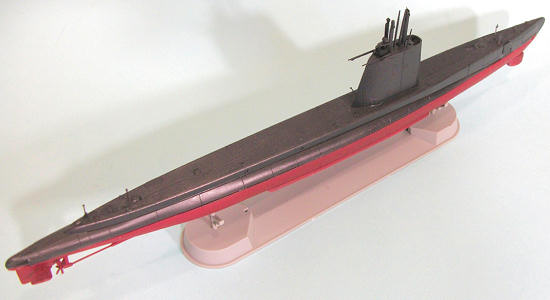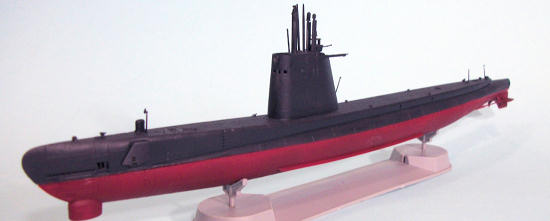AFV Club 1/350 Guppy II Submarine
|
KIT #: |
73513 |
|
PRICE: |
Yen 2,240 (20% off
at HLJ) |
|
DECALS: |
Two options |
|
REVIEWER: |
Tom Cleaver |
|
NOTES: |
Built OOB
|

The major technological advance in diesel-electric submarines was the
development of the snorkel, which allowed the operation of the diesel engines at
periscope depth, and the development of the Type XXI U-boat by the Germans, the
first  submarine
designed for greater performance underwater than on the surface. The snorkel was
widely adopted by the navies of the world and improved after the war, while the
Type XXI submarine revolutionized submarine design in all navies.
submarine
designed for greater performance underwater than on the surface. The snorkel was
widely adopted by the navies of the world and improved after the war, while the
Type XXI submarine revolutionized submarine design in all navies.
The US Navy designed the “Tang” class to take advantage of everything
learned from the Type XXI U-boat, the new boats were so much better they made
the existing fleet boat obsolete, but these were too expensive in the post-war
period to produce enough of them to satisfy all the needs for submarines.
In 1949, the Navy began the Greater Underwater Propulsive Power Program,
for which the acronym GUPPY was created by dropping the last “P” to convert and
back-fit existing late production “Gato” and “Balao” class fleet submarines with
many of the German Type XXI submarine design features. Deck guns and
anti-aircraft armament were removed, the outer hull was streamlined, the conning
tower replaced by a streamlined sail, larger propellers were fitted, more air
conditioning was installed for the greater heat generated by t he
electric motors, and the battery capacity doubled. The end result was submarines
which were capable of 18.2 knots submerged, equaling the Type XXI, and exceeding
their surfaced speed by 0.4 knots.
he
electric motors, and the battery capacity doubled. The end result was submarines
which were capable of 18.2 knots submerged, equaling the Type XXI, and exceeding
their surfaced speed by 0.4 knots.
The GUPPY program included three major phases. Guppy I, which was
essentially experimental, involved only two boats, Odax (SS‑484) and
Pomodon (SS‑486), which both became part of the main program, and led to the
GUPPY IA
AND
IB boats; GUPPY II, which converted 24 boats during the late 1940s and early
1950s by reducing the diesels from four to three to increase battery size and
power; and GUPPY
III,
which updated several GUPPY II submarines by lengthening the hull for additional
equipment. The ke y
features of all three were extensive streamlining of the hull and sail, larger
and more powerful batteries, and a snorkel air‑breathing system.
y
features of all three were extensive streamlining of the hull and sail, larger
and more powerful batteries, and a snorkel air‑breathing system.
The GUPPY II and
III
submarines were distinguished by a tall sail, termed the “northern sail.” These
boats were "rode hard." In the
Atlantic,
they had to support ASW training with US and NATO Task Groups, run barrier
patrols in the Greenland-Iceland-UK-Gap, that narrow passage through which the
Soviet submarines would deploy to threaten the Atlantic sea lanes.
In the Pacific, boats from
Pearl Harbor,
San Diego
and
Yokosuka
watched the exit points from the North Pacific ports such as
Vladivostok.
US and other NATO boats watched the
Kola Peninsula.
These deployments often found the
boats in extremely rough weather; on the North Atlantic run, they operated in
Force 5 and 6 and higher seas constantly, while those in the Pacific often had
to deal with typhoons and enormous storms out of the Gulf of Alaska. The
streamlined GUPPY bow dug deep into the waves and the early “step sail” gave
little protection to the bridge crew, while control during snorkeling was
difficult at best and sometimes
impossible. The tall “northern
sail” solved the problems, and eventually all GUPPY boats were so modified
during their careers.
Most information about the operations of GUPPY submarines during the Cold
War remains classified to this day.
Without converting the fleet boats of World War II to the GUPPYs of the Cold War
era, the success of submarine cold war operations
would not have been possible.
These submarines "held the line" until the SSNs and SSBNs took over.
This is the fourth or fifth iteration of the development of the
US
Fleet boat from the 1941 configuration to the Gupppy-II as represented in this
kit. The hull is divided at the
waterline, allowing it to be built as a waterline model for an at-sea underway
diorama. All parts are crisply molded.
Decals are p rovided
to do either USS Cutlass (SS-478), or the same submarine as now operated by the
Republic of
China
(Taiwan)
navy as the “Sea Lion,” which is now the oldest diesel-electric submarine in the
world as of March 2011.
rovided
to do either USS Cutlass (SS-478), or the same submarine as now operated by the
Republic of
China
(Taiwan)
navy as the “Sea Lion,” which is now the oldest diesel-electric submarine in the
world as of March 2011.
The
AFV
Club Guppy II kit is as good as the other US fleet boat kits they make, and
provides a very hassle-free project to create a Guppy II submarine.
It took me the better part of an afternoon to assemble the kit, with the
biggest problem being the extremely small deck cleats, which I finally figured
out how to attach them to the deck without making a contribution to the Carpet
Monster.
Most GUPPY boats operated in a flat black overall scheme above the water
line with lower hulls in red anti-fouling paint.
While they carried hull numbers on the sail and bow while in port or on
non-operational cruises, when they went to war they painted out the numbers.
The kit was painted with Tamiya “Flat Black,” highlighted with “NATO
Black”, and Tamiya “Hull
Red.”
An easy kit that provides an interesting development of the
US
fleet boats.
Tom
Cleaver
January 2012
Review Kit courtesy of
HobbyLink
Japan.
If you would like your product reviewed fairly and fairly quickly, please contact the editor or see other details in the Note to
Contributors.
Back to the Main Page
Back to the Review
Index Page


 submarine
designed for greater performance underwater than on the surface. The snorkel was
widely adopted by the navies of the world and improved after the war, while the
Type XXI submarine revolutionized submarine design in all navies.
submarine
designed for greater performance underwater than on the surface. The snorkel was
widely adopted by the navies of the world and improved after the war, while the
Type XXI submarine revolutionized submarine design in all navies. he
electric motors, and the battery capacity doubled. The end result was submarines
which were capable of 18.2 knots submerged, equaling the Type XXI, and exceeding
their surfaced speed by 0.4 knots.
he
electric motors, and the battery capacity doubled. The end result was submarines
which were capable of 18.2 knots submerged, equaling the Type XXI, and exceeding
their surfaced speed by 0.4 knots. y
features of all three were extensive streamlining of the hull and sail, larger
and more powerful batteries, and a snorkel air‑breathing system.
y
features of all three were extensive streamlining of the hull and sail, larger
and more powerful batteries, and a snorkel air‑breathing system.  rovided
to do either USS Cutlass (SS-478), or the same submarine as now operated by the
Republic of
rovided
to do either USS Cutlass (SS-478), or the same submarine as now operated by the
Republic of